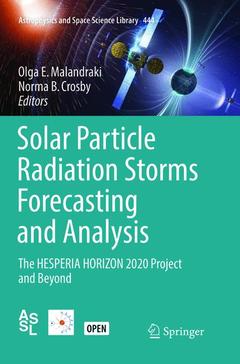Description
Solar Particle Radiation Storms Forecasting and Analysis, 1st ed. 2018
The HESPERIA HORIZON 2020 Project and Beyond
Astrophysics and Space Science Library Series, Vol. 444
Coordinators: Malandraki Olga E., Crosby Norma B.
Language: English
Subjects for Solar Particle Radiation Storms Forecasting and Analysis:
Solar Particle Radiation Storms Forecasting and Analysis
Publication date: 06-2019
203 p. · 15.5x23.5 cm · Paperback
Publication date: 06-2019
203 p. · 15.5x23.5 cm · Paperback
Solar Particle Radiation Storms Forecasting and Analysis
Publication date: 02-2018
Support: Print on demand
Publication date: 02-2018
Support: Print on demand
Description
/li>Contents
/li>Biography
/li>Comment
/li>
Solar energetic particles (SEPs) emitted from the Sun are a major space weather hazard motivating the development of predictive capabilities. This book presents the results and findings of the HESPERIA (High Energy Solar Particle Events forecasting and Analysis) project of the EU HORIZON 2020 programme. It discusses the forecasting operational tools developed within the project, and presents progress to SEP research contributed by HESPERIA both from the observational as well as the SEP modelling perspective. Using multi-frequency observational data and simulations HESPERIA investigated the chain of processes from particle acceleration in the corona, particle transport in the magnetically complex corona and interplanetary space, to the detection near 1 AU. The book also elaborates on the unique software that has been constructed for inverting observations of relativistic SEPs to physical parameters that can be compared with sp
ace-borne measurements at lower energies. Introductory and pedagogical material included in the book make it accessible to students at graduate level and will be useful as background material for Space Physics and Space Weather courses with emphasis on Solar Energetic Particle Event Forecasting and Analysis.This book is published with open access under a CC BY license.
Preface.- Solar Energetic Particles and Space Weather: Science and Applications.- Eruptive Solar Activity related to SEP Events.- Charged Particle Transport in the Interplanetary Medium.- Particle Transport in the Earth’s Magnetosphere.- Ground-Based Measurements of High-Energy Particles by Neutron Monitors.- HESPERIA Forecasting Tools: Real-Time and Post-Event.- Gamma-Ray, Radio and SEP Observations of Relativistic Events.- Modelling of Shock-Accelerated Gamma-Ray Events.- Inversion Methodology of Ground Level Enhancements.
Dr. Olga E. Malandraki, Ph.D. is a Senior Researcher at the National Observatory of Athens, IAASARS. She has wide expertise in the analysis and interpretation of SEP data from the Ulysses, ACE, Wind and STEREO missions. She has investigated the magnetic topology of ICMEs using SEPs as tracers, the effect of the large-scale structure of the IMF on the propagation of energetic particles, the propagation of energetic particles inside Corotating Interactions Regions (CIRs), the solar origin of SEP events, the physical mechanisms leading to the establishment and maintenance of the so-called 'particle reservoirs' in the heliosphere, the propagation of energetic particles over the poles of the Sun, multi-spacecraft compositional SEP studies in the 3-D heliosphere as well as SEP forecasting and space weather impacts. The results of her studies have been published in more than 55 papers in refereed journals which have attracted a large number of citations. She serves as an Associate Editor andEditorial Board Member of two international peer-review journals as well as Co-editor for conference proceedings (e.g. Proceedings of the International Astronomical Union (IAU) Symposium Nr. 335 on “Space Weather of the Heliosphere: Processes and Forecasts”). She frequently contributes as referee in journals such as Solar Physics, Astrophysical Journal, Journal of Geophysical Research – Space Physics, Planetary and Space Science, Space Weather: The International Journal of Research and Applications. She acts as ‘Deputy President’ and ‘Heliosphere Science Officer’ of the Solar-Terrestrial Sciences Division of the European Geosciences Union (EGU), as Spokesperson of the Space Weather Working Team (SWWT) Topical Working sub-group on 'Solar Energetic Particles' of the European Space Agency (ESA), Chair of the Steering Committee of the ‘Balkan, Black Sea and Caspian Sea Regional Network for Space Weather Studies’ comprising 13 countries, as well as Organizing Committee
Explains why it is important to understand the effects of solar energetic particles (SEPs) and be able to predict them from a modern society perspective Presents most recent state-of-the-art scientific results on SEPs Provides the reader with basic textbook type chapters on SEP origin, SEP acceleration and propagation, SEP interpretation, and SEP forecasting Can be used both as background course material to complement other textbook material, as well as a reference book for more senior scientists
© 2024 LAVOISIER S.A.S.




